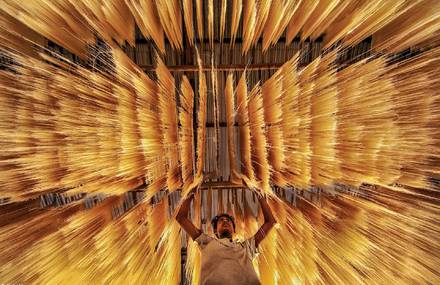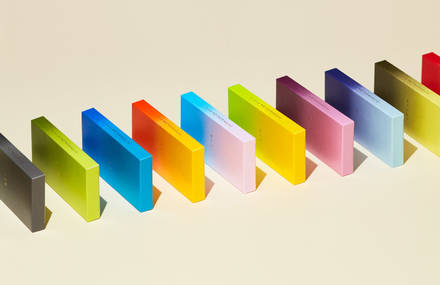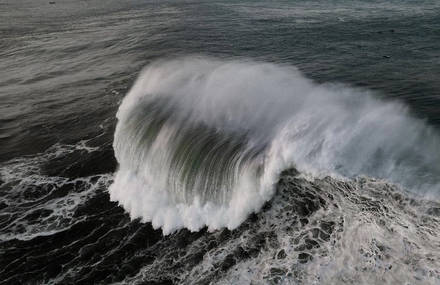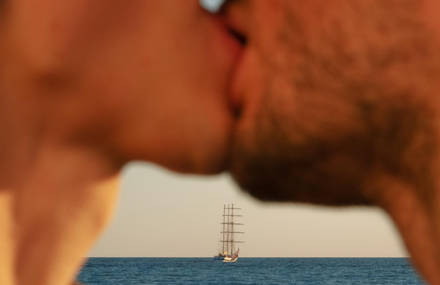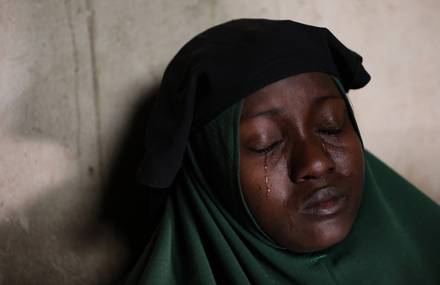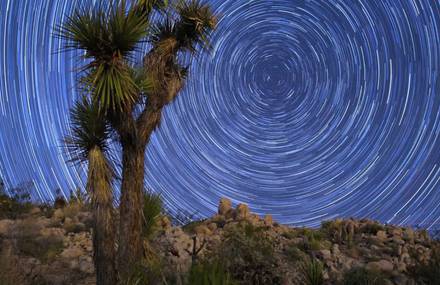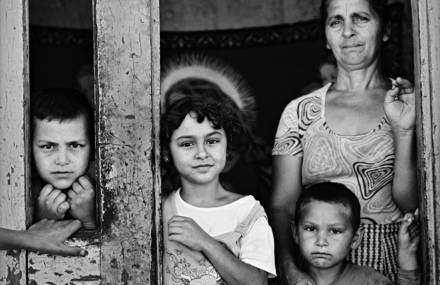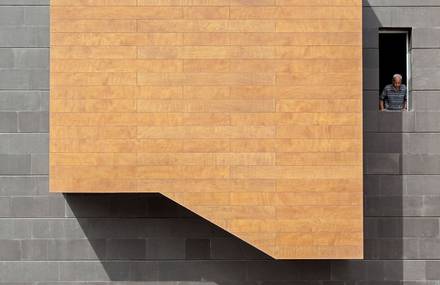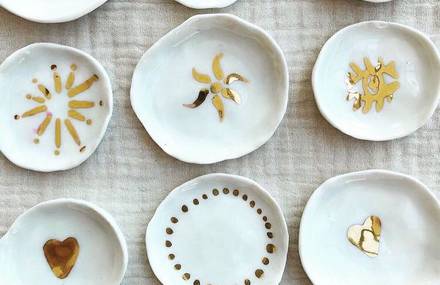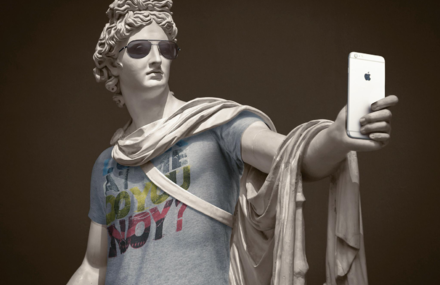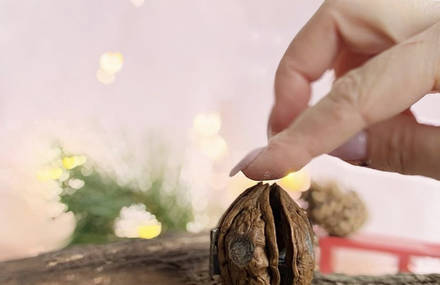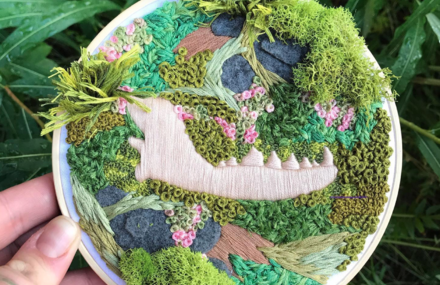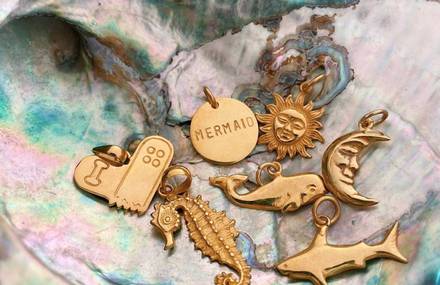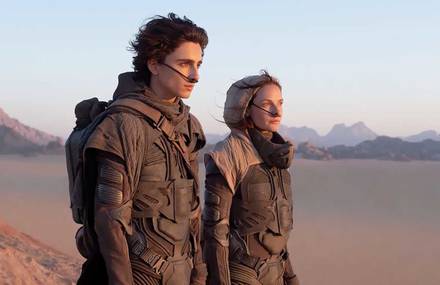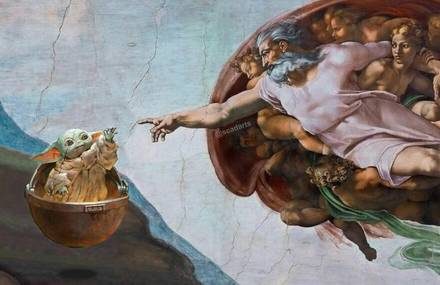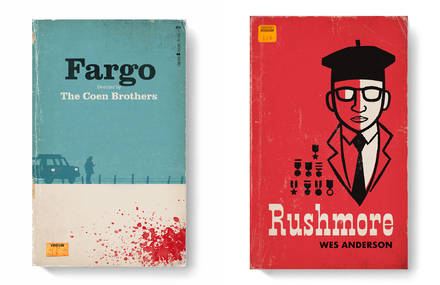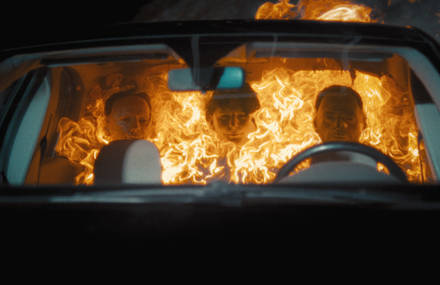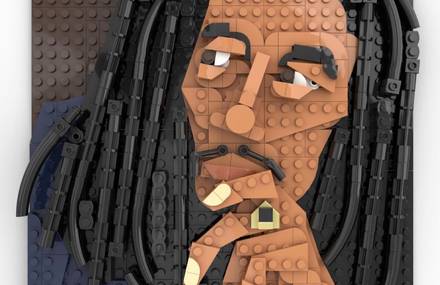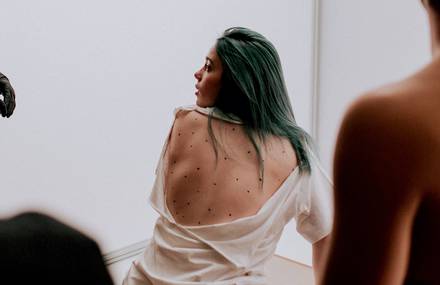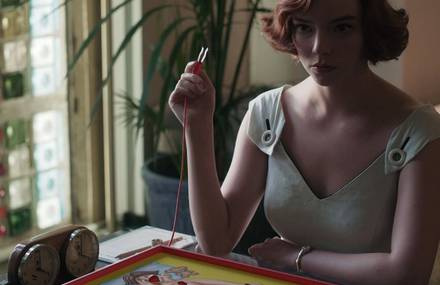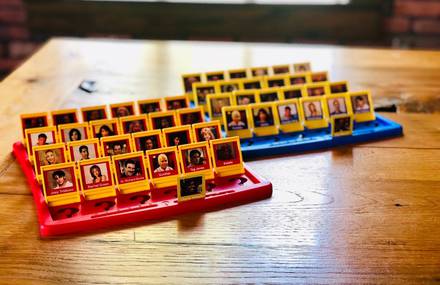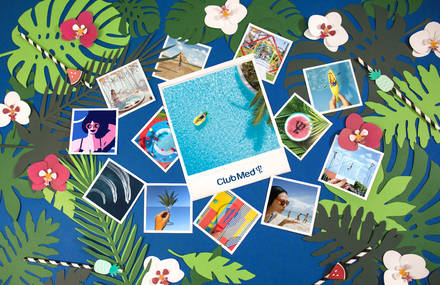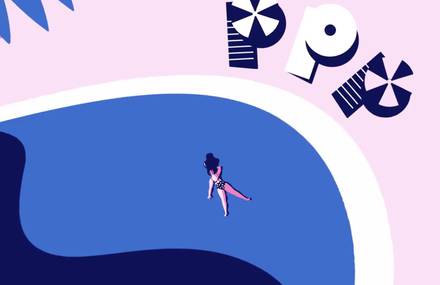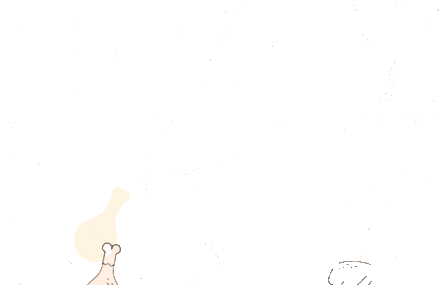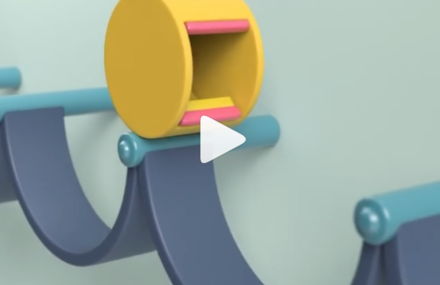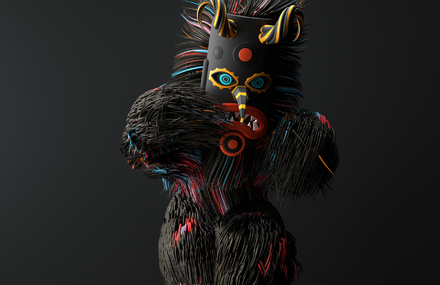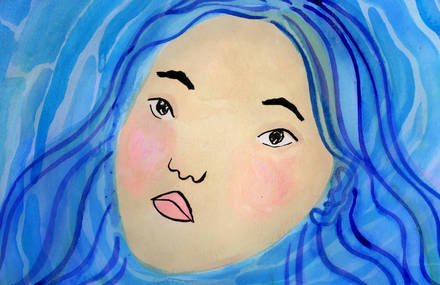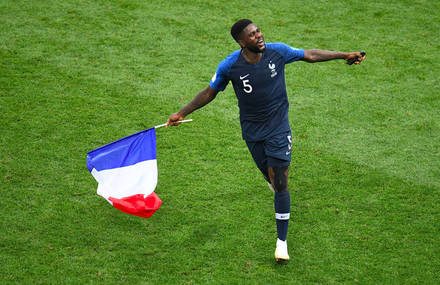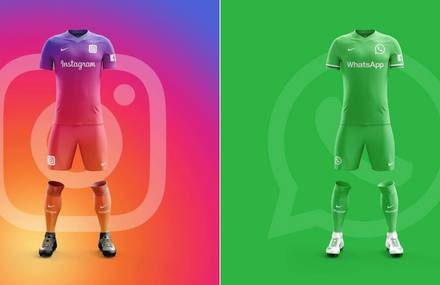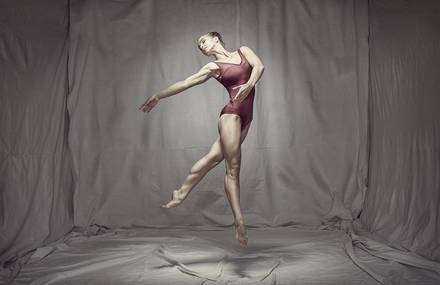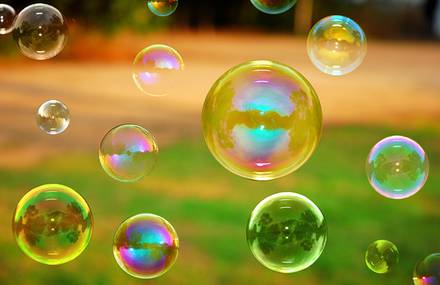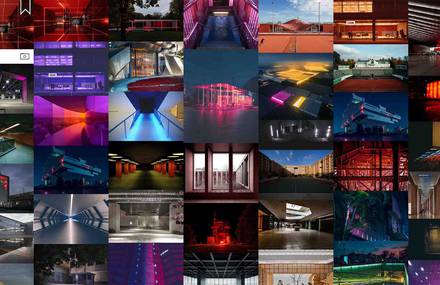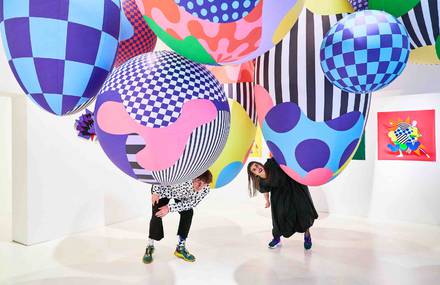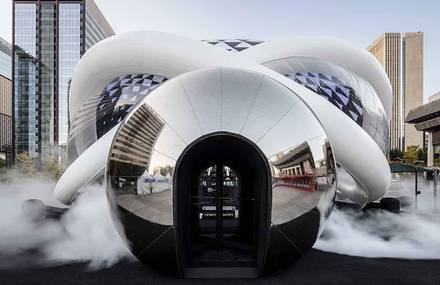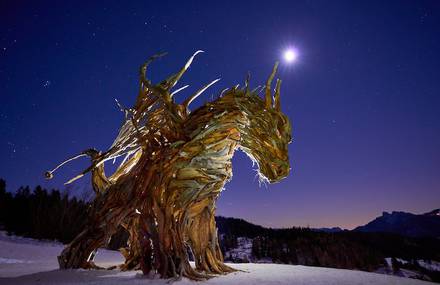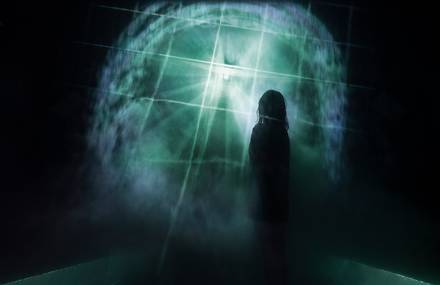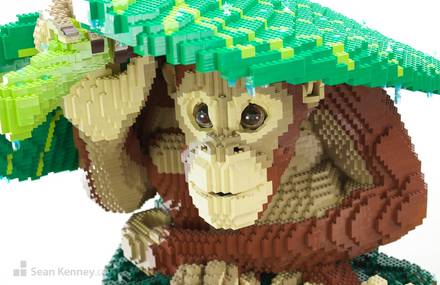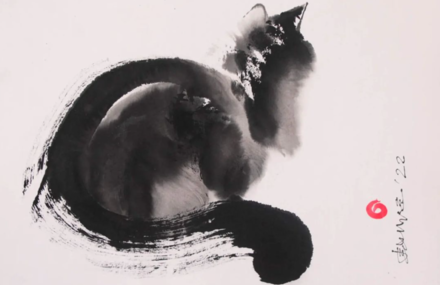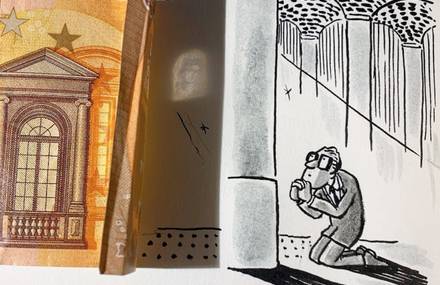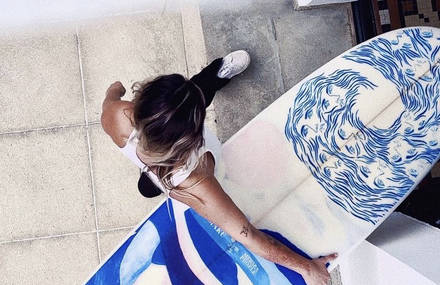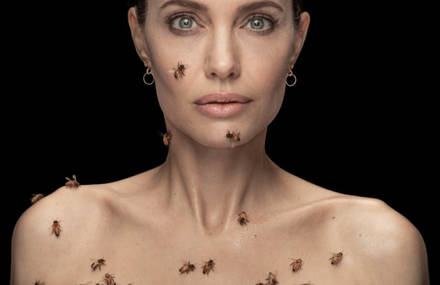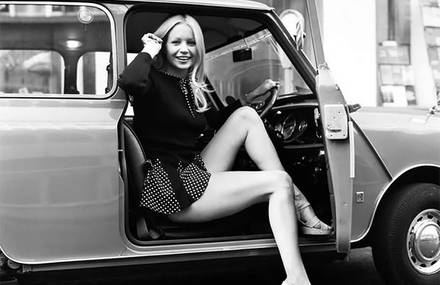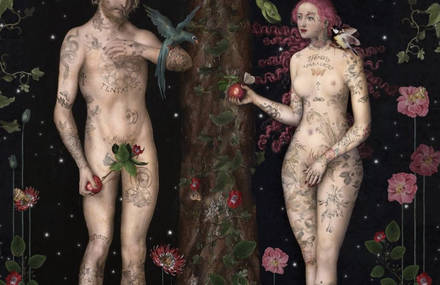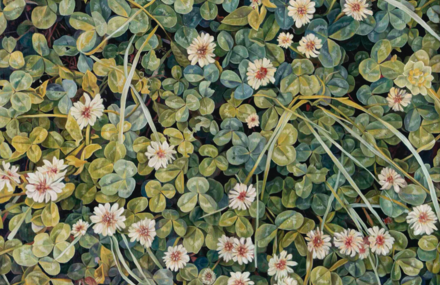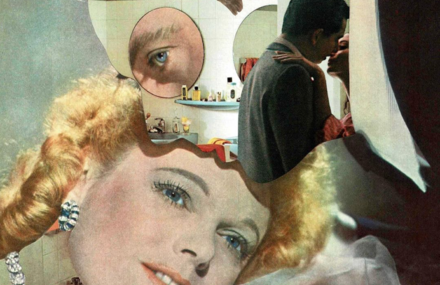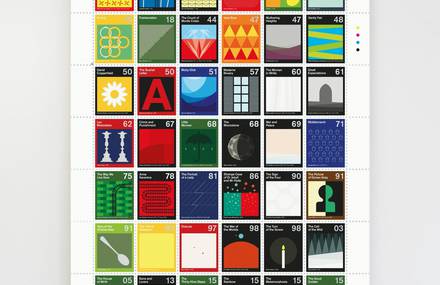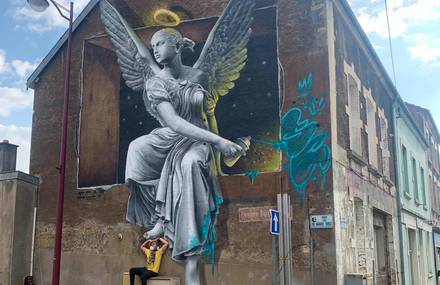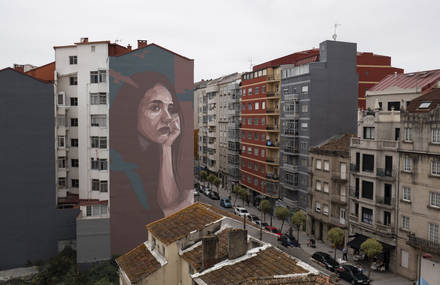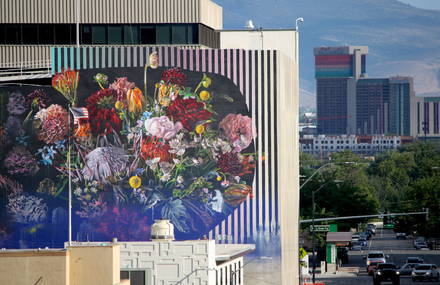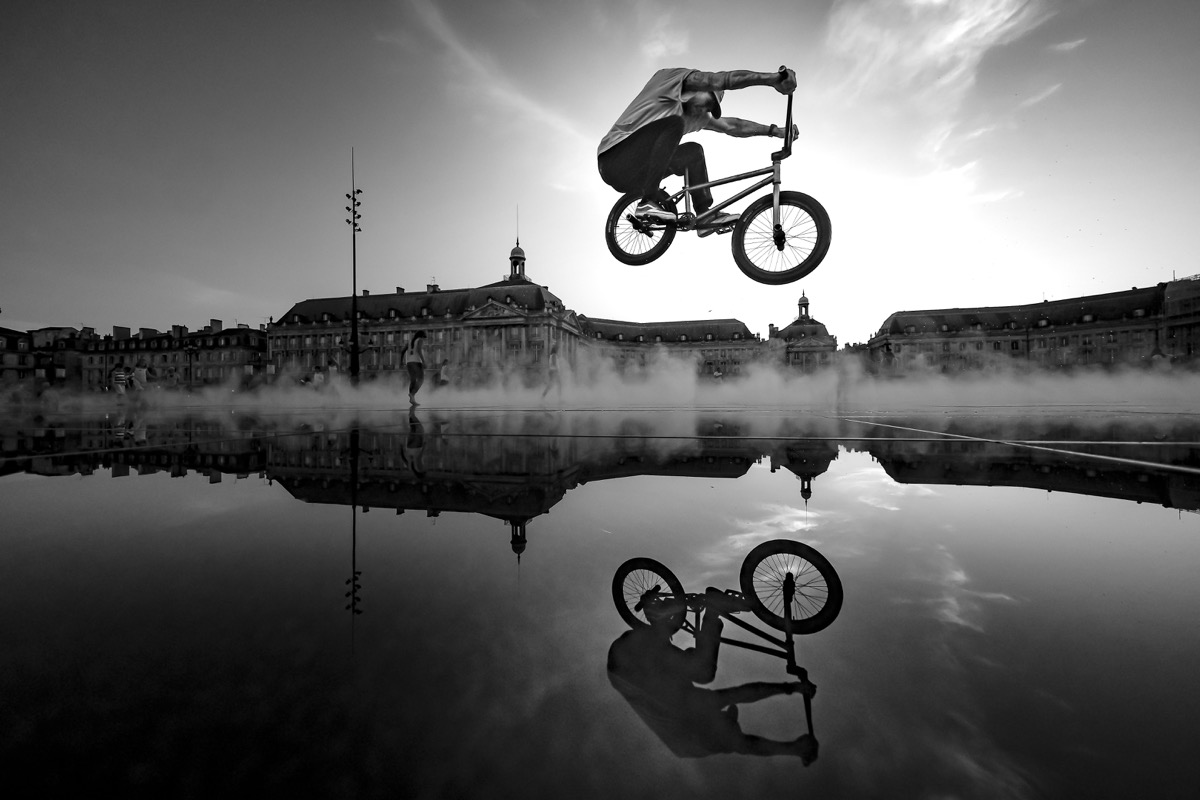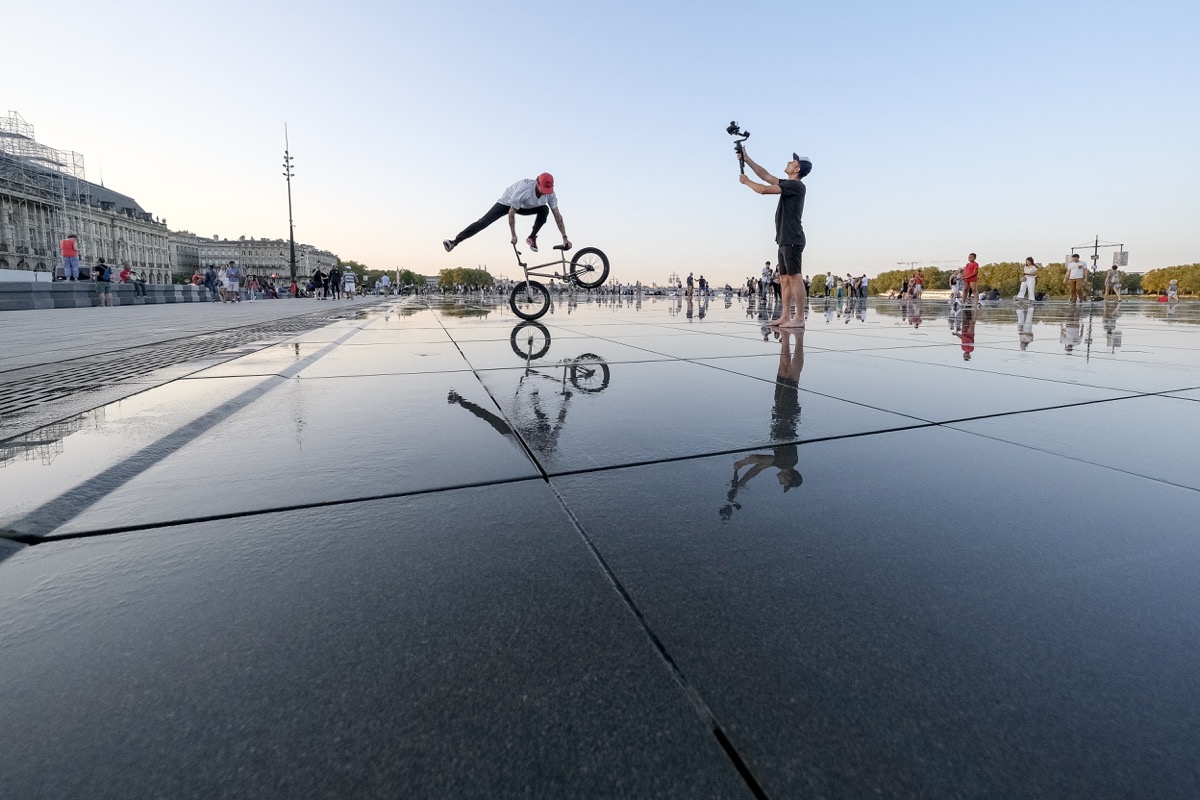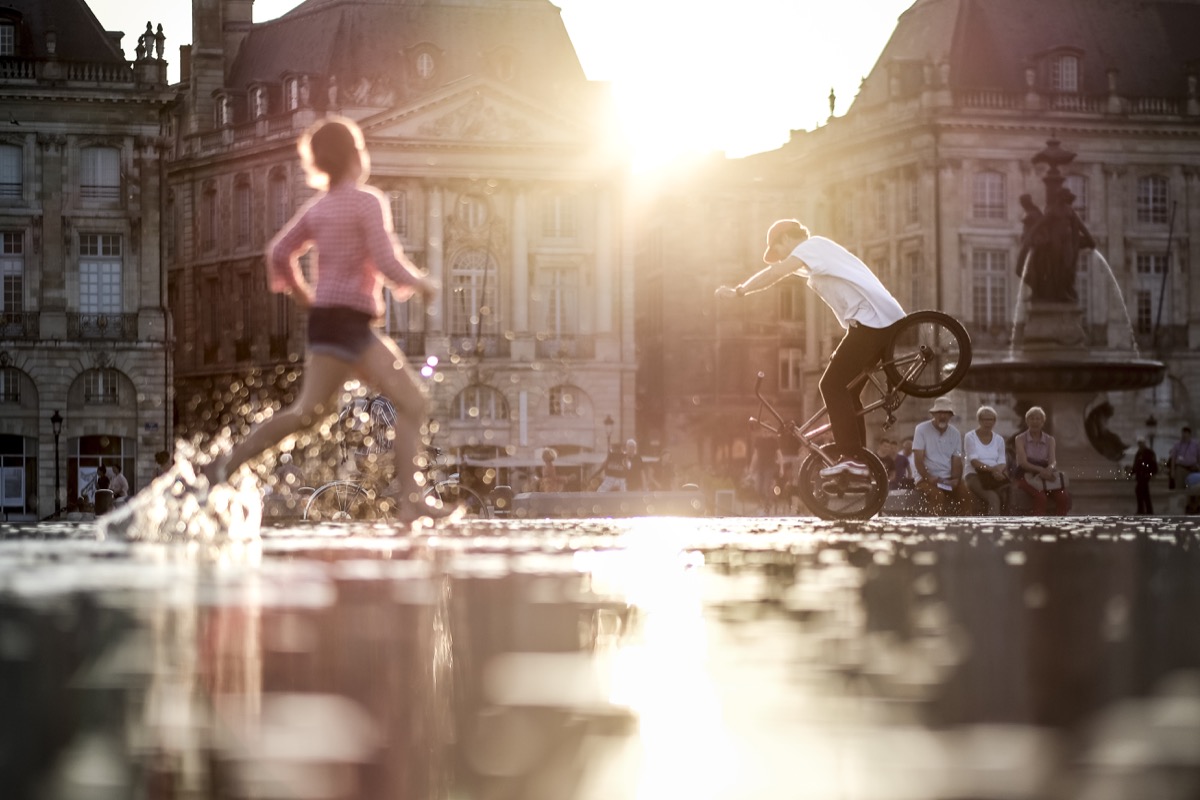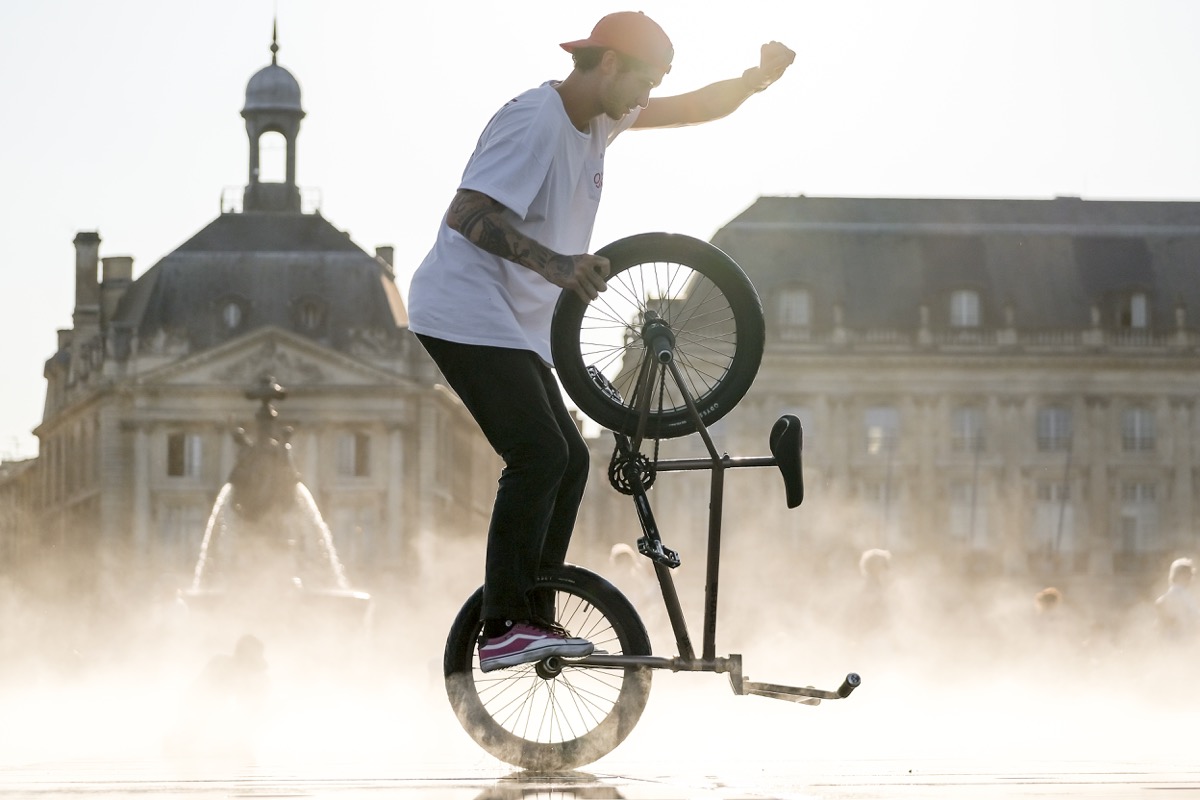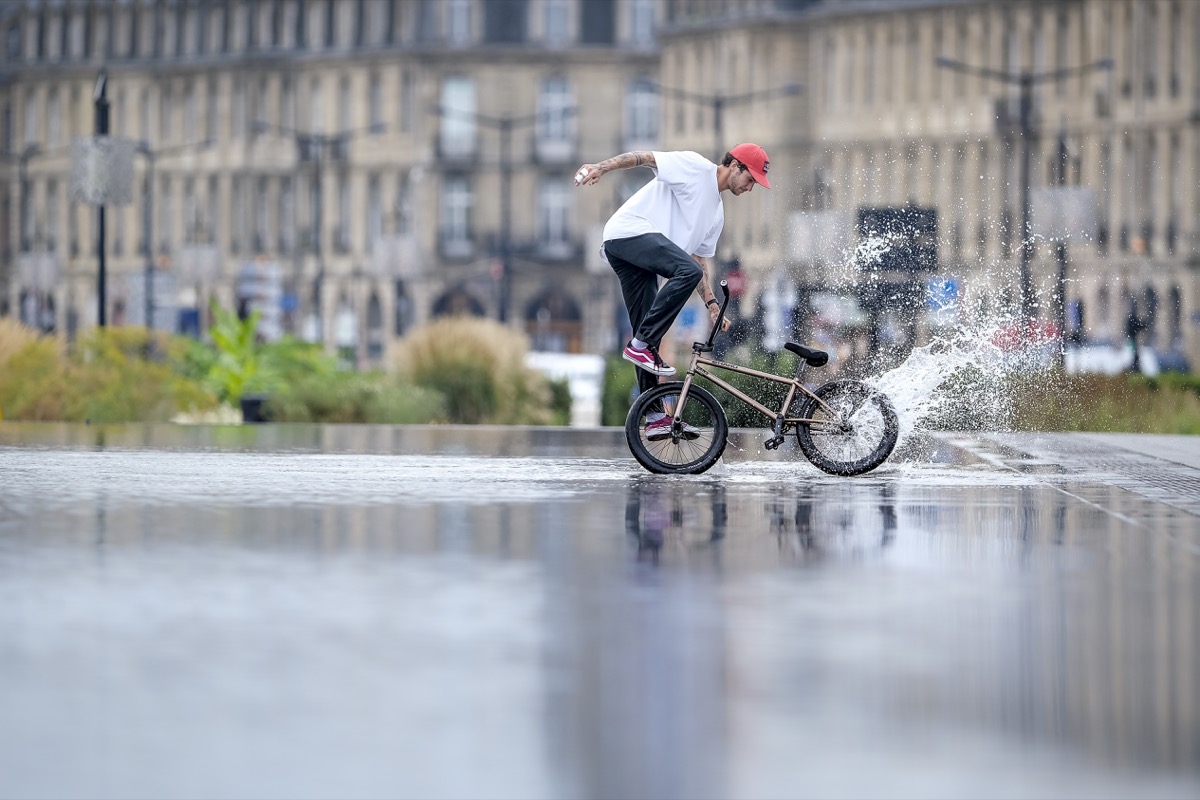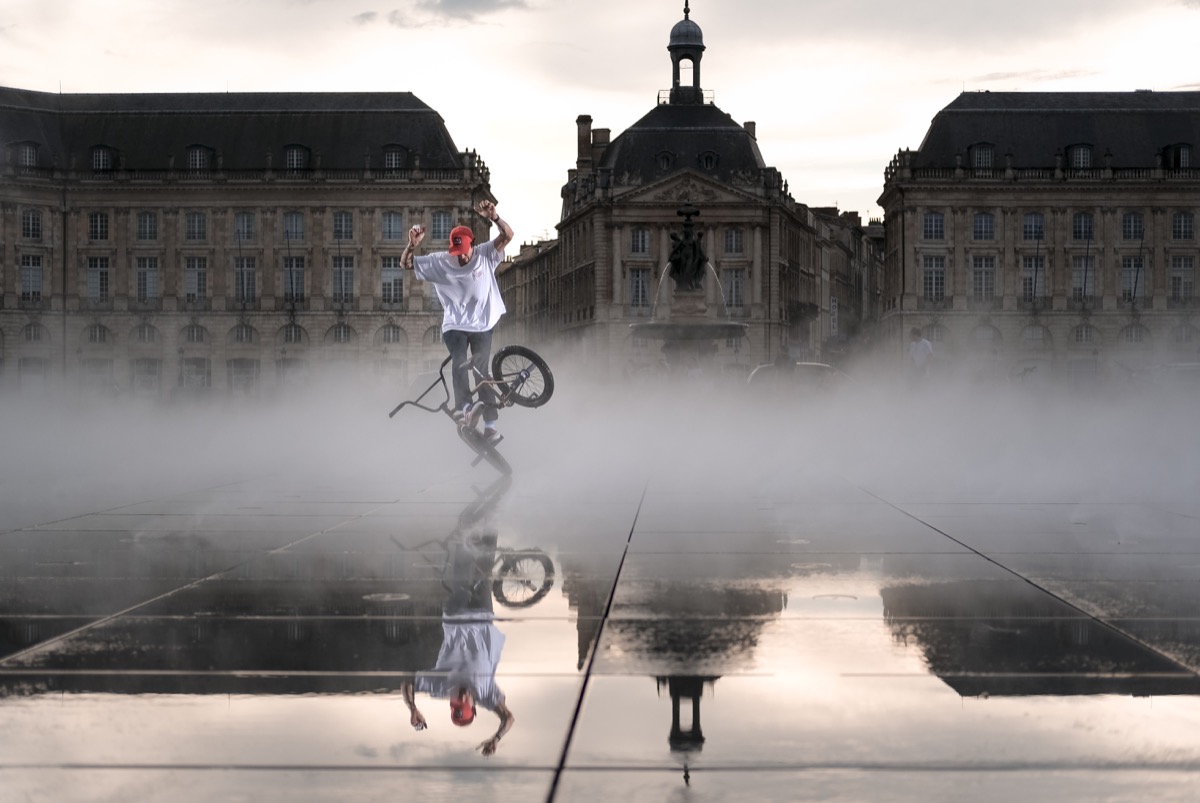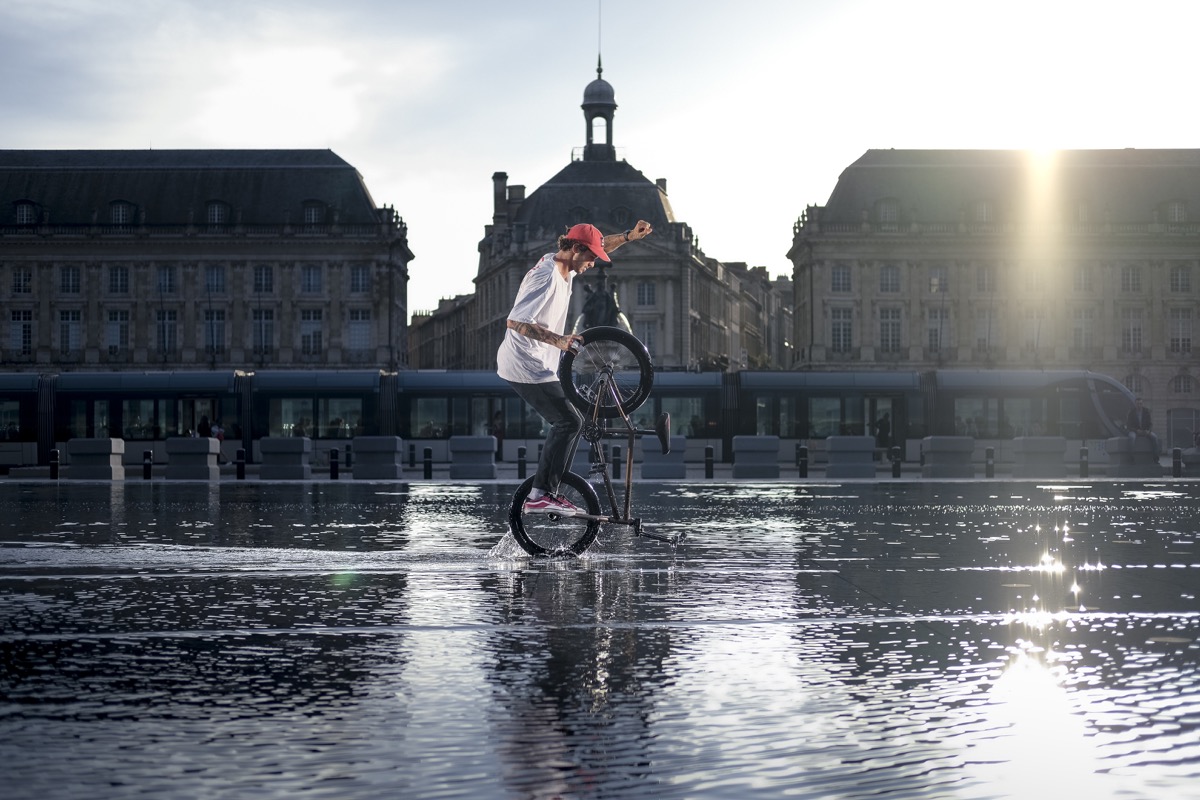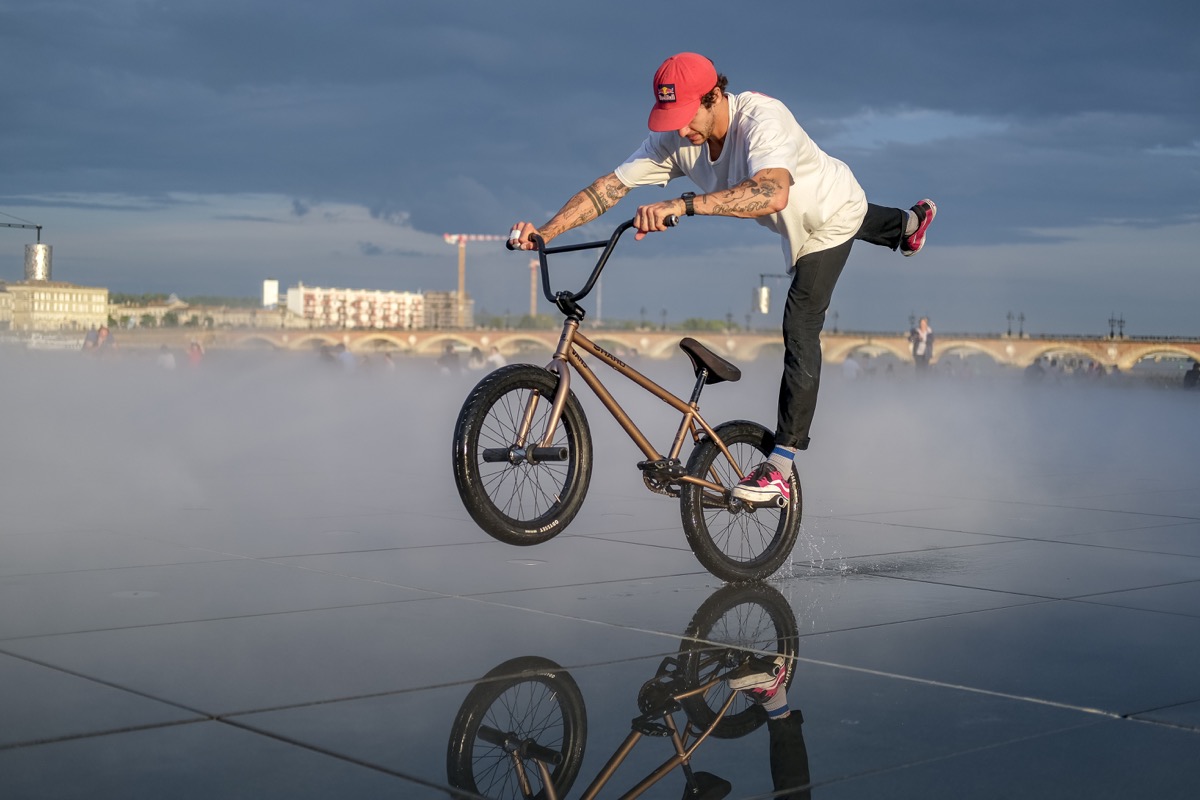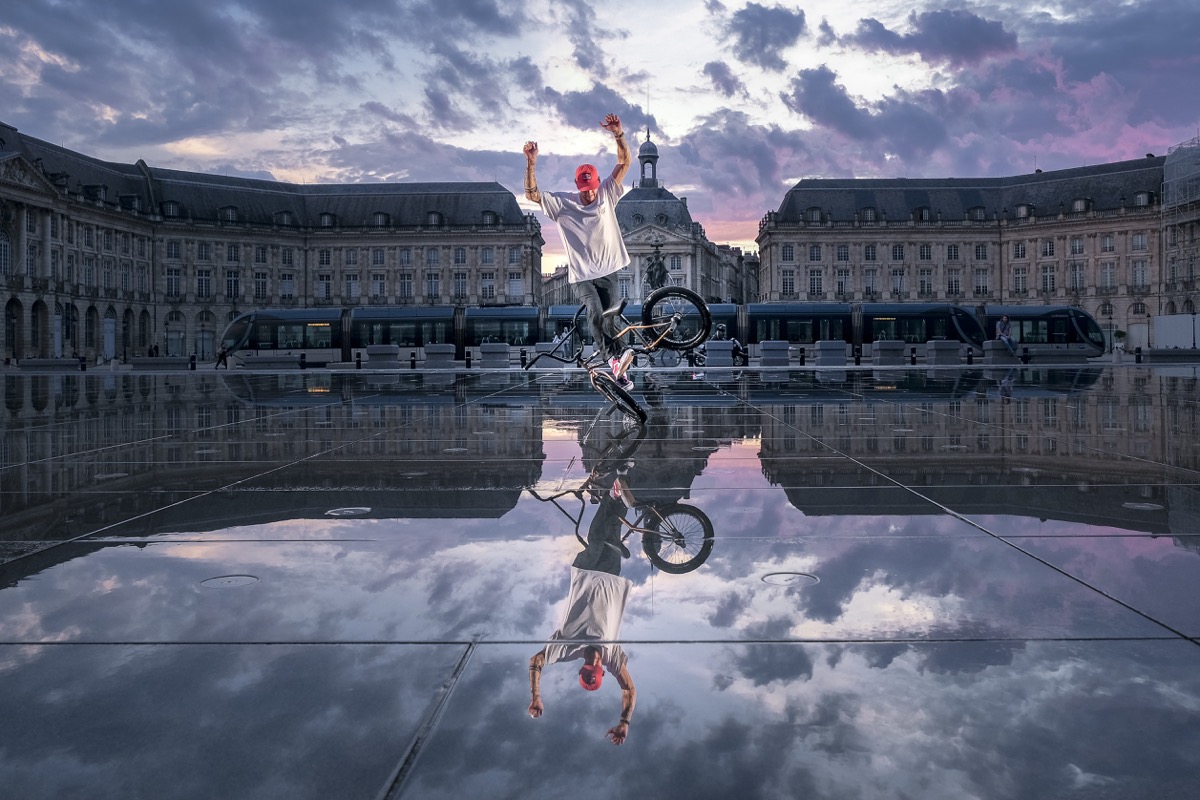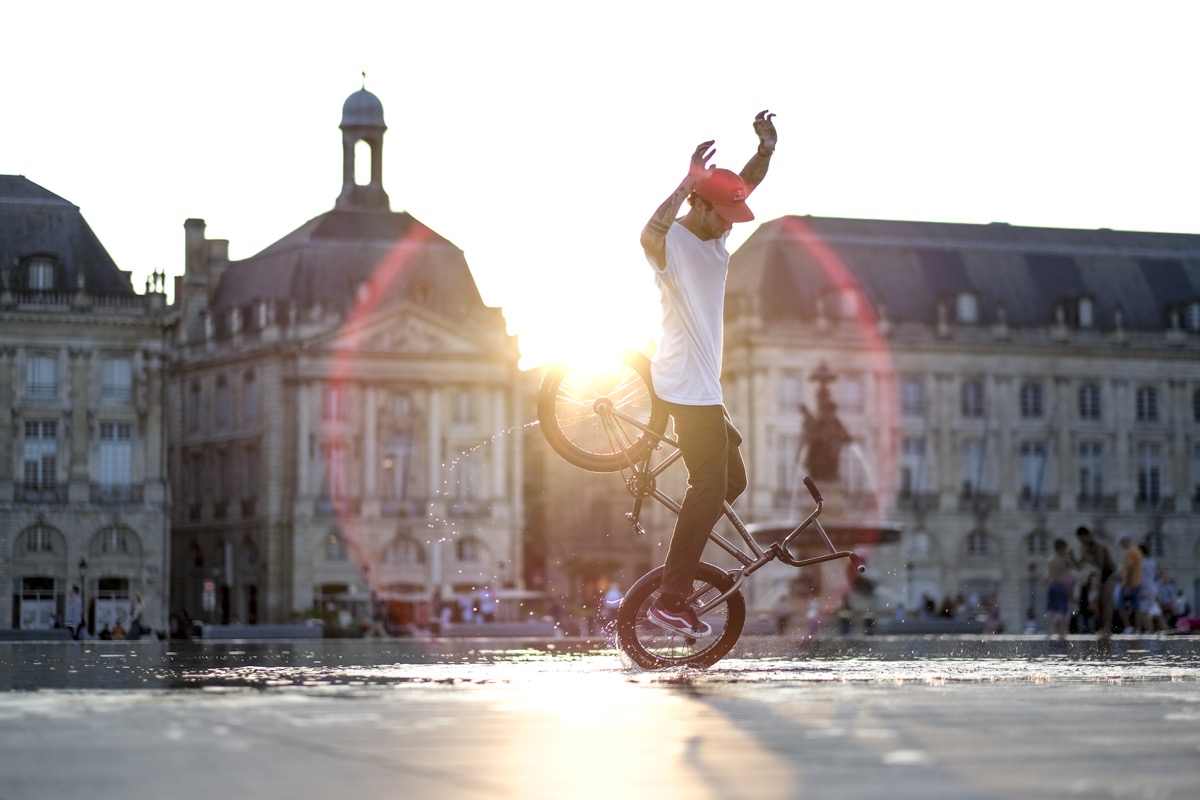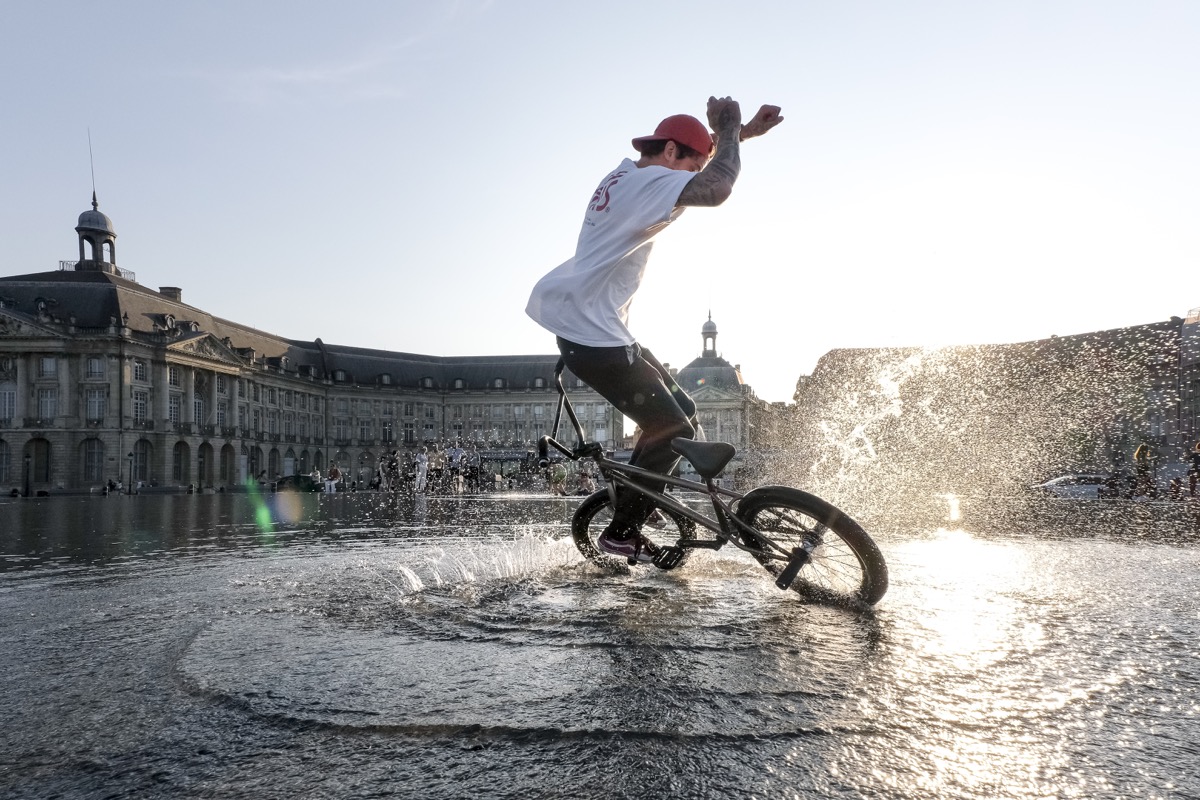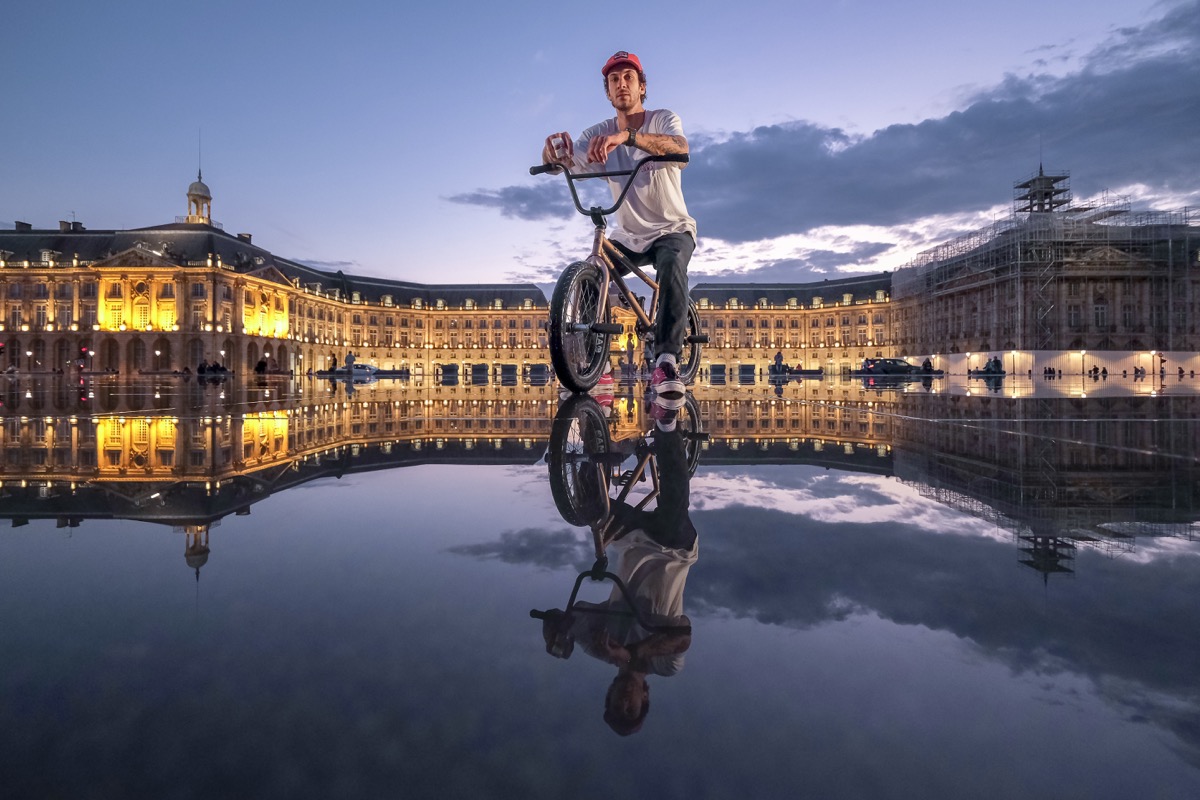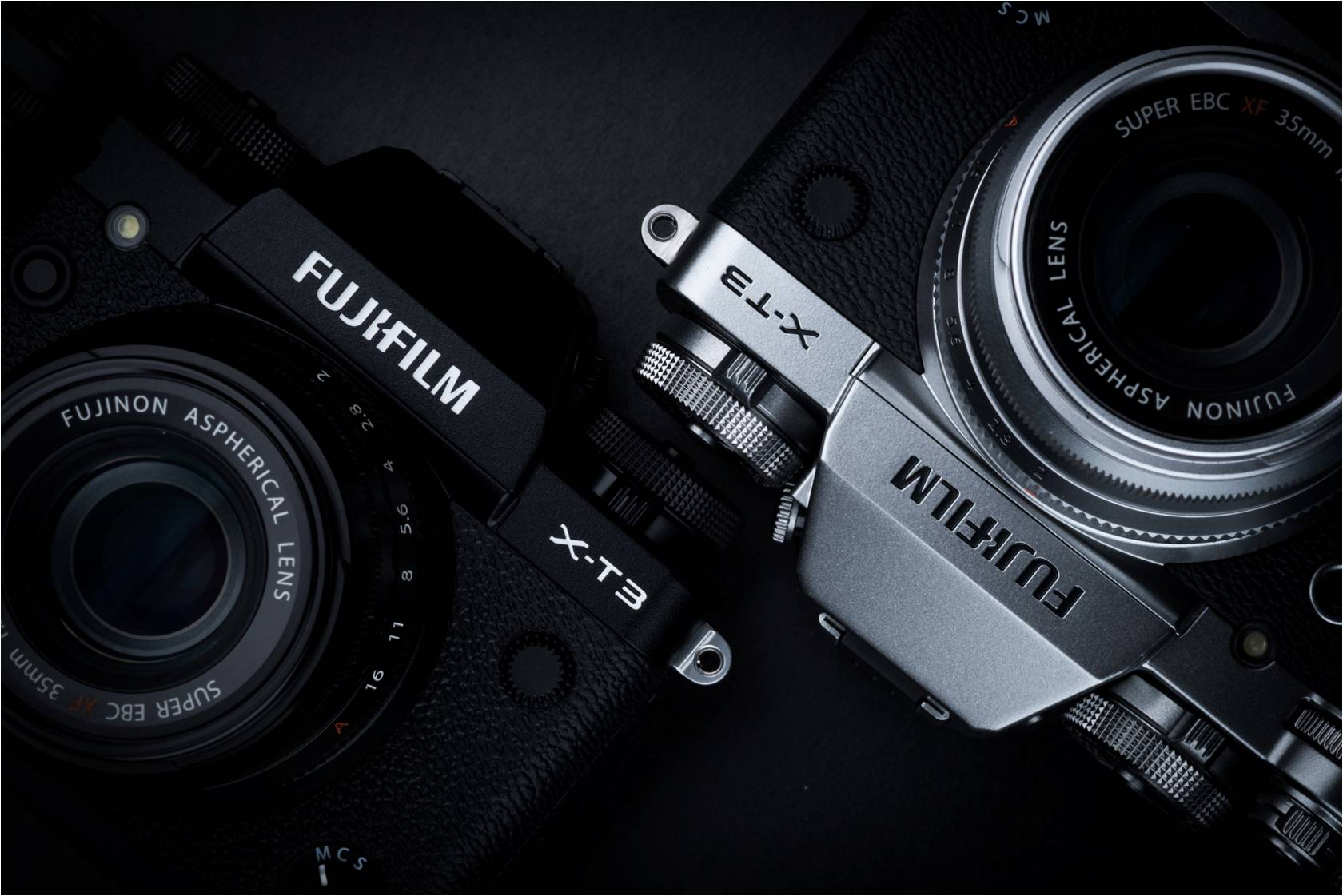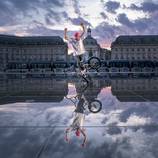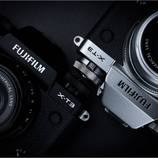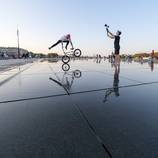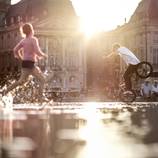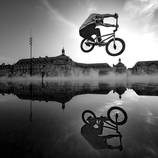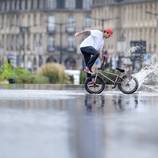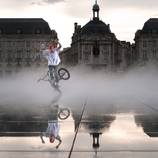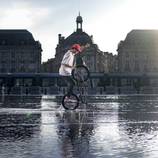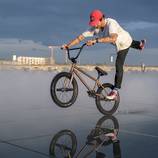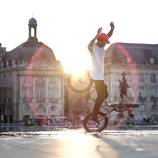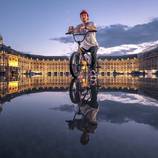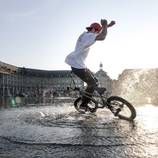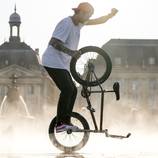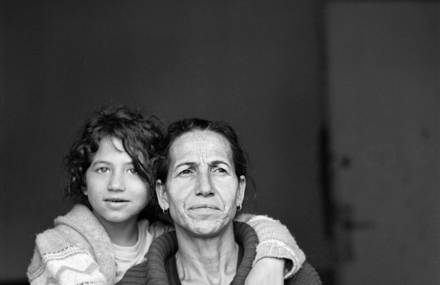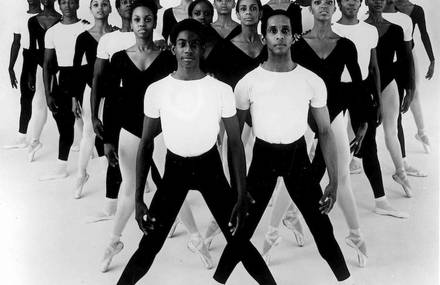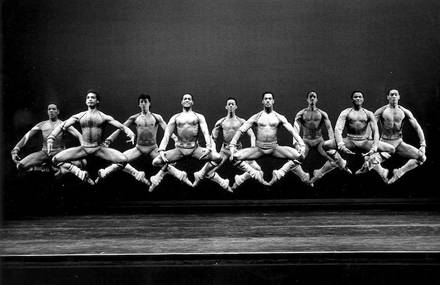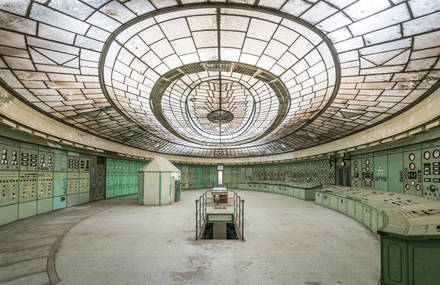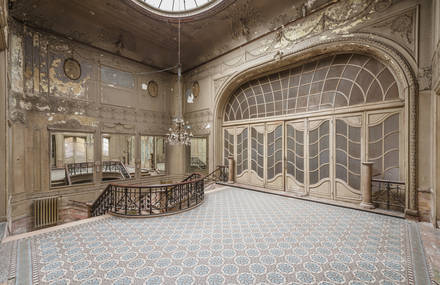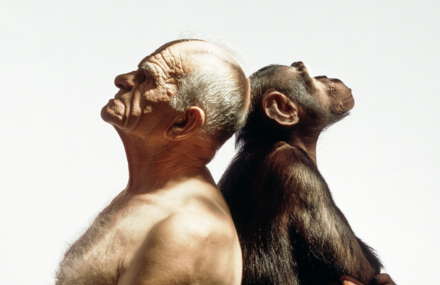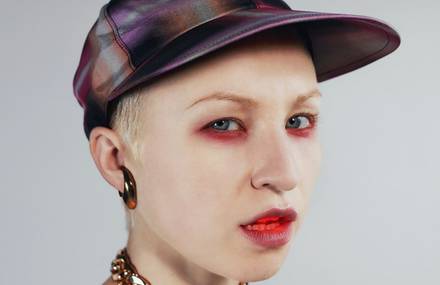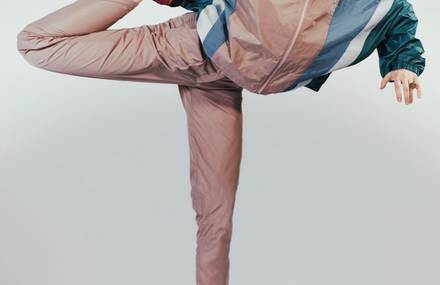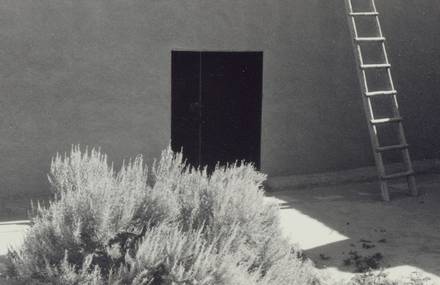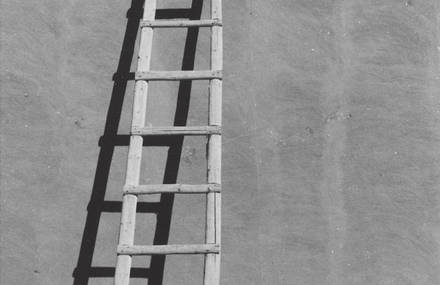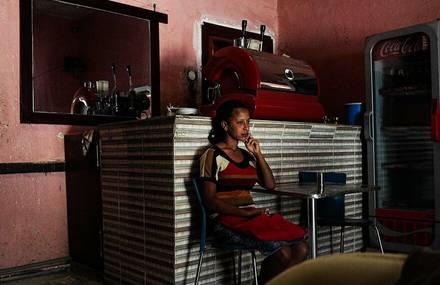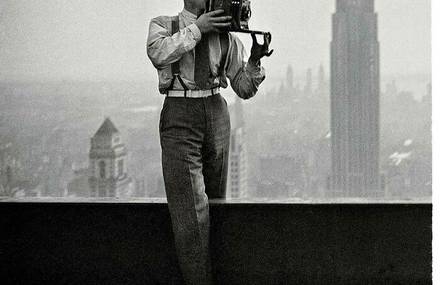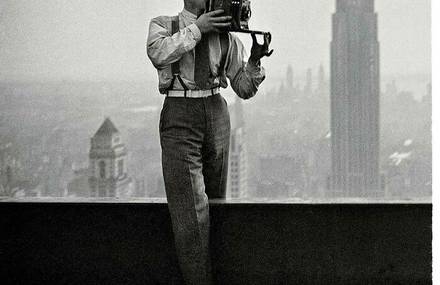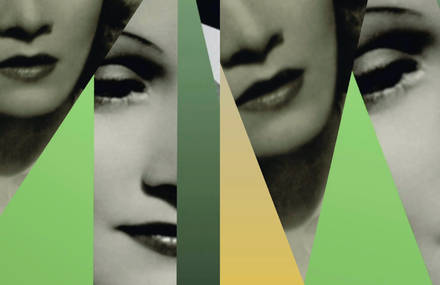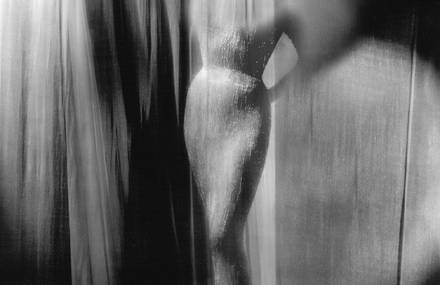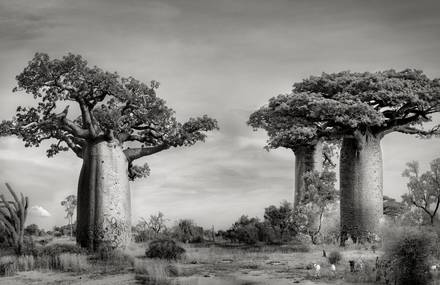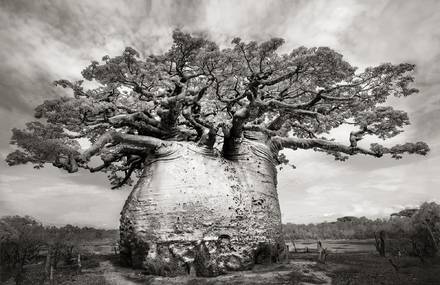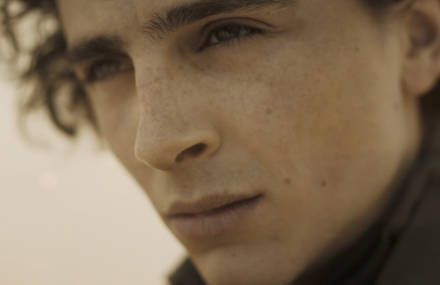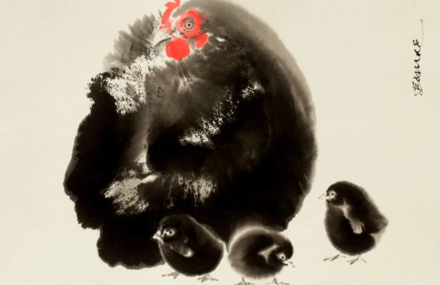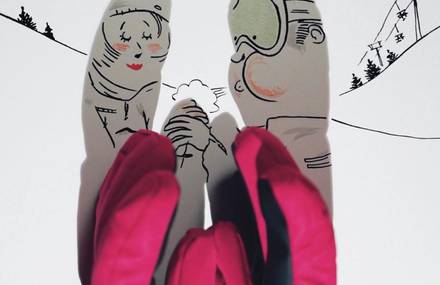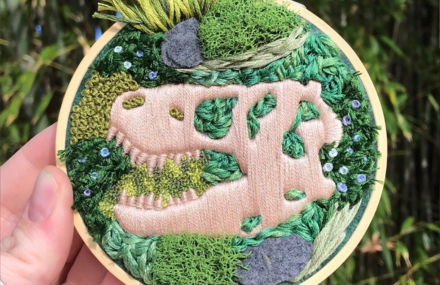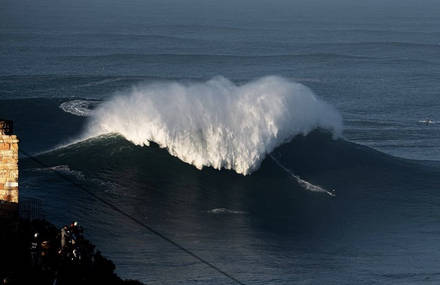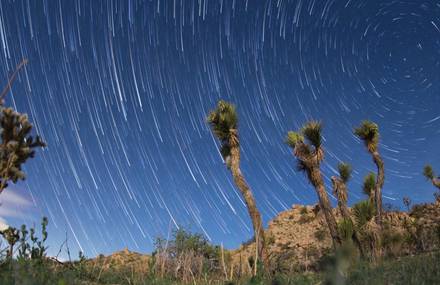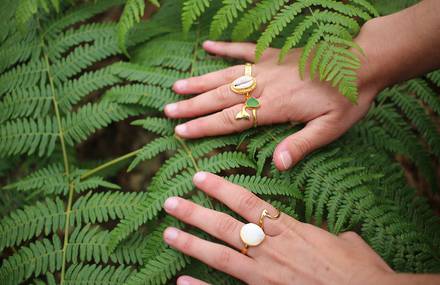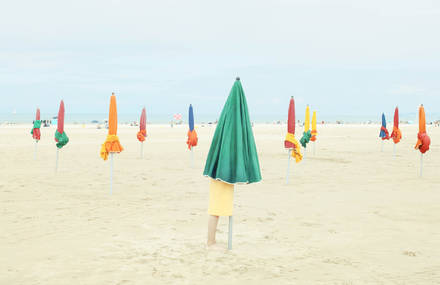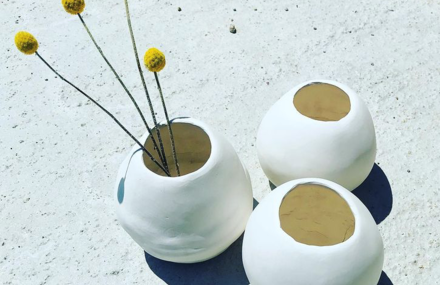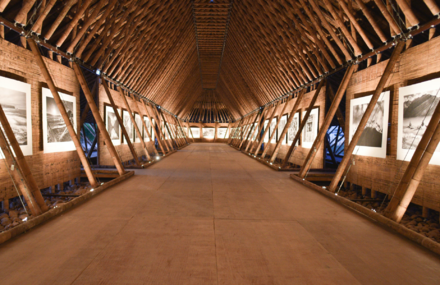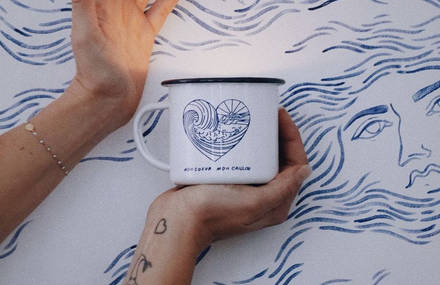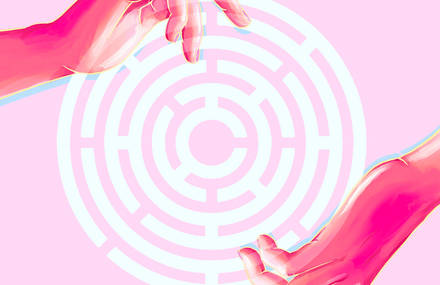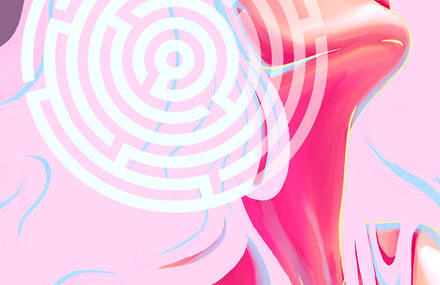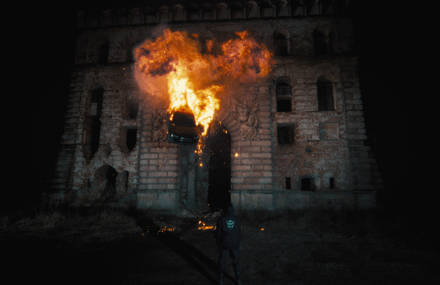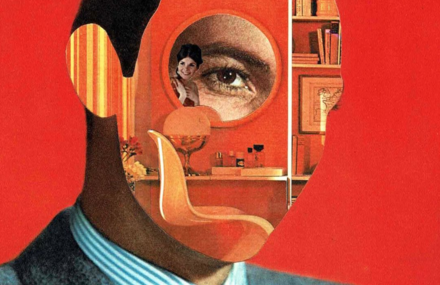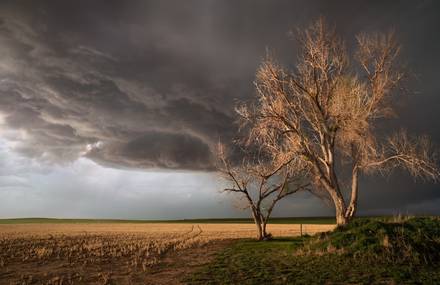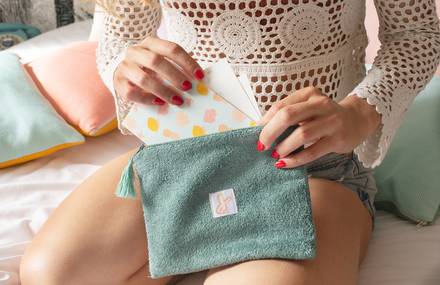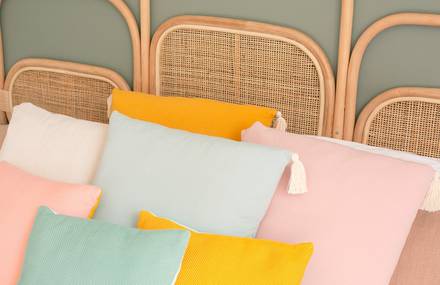A few weeks ago Fujifilm unveiled the latest camera: the Fujifilm X-T3. To present the capabilities of this device, what better than a project involving photo and video? This is the promise of the ECHO project imagined by Fujifilm around BMX FLAT, a discipline in constant evolution. The French rider, six times world champion, Matthias Dandois, the video artist Pierre Blondel and the photographer Tristan Shu have beautifully put in image this project. He positions the Fujifilm X-T3 in the world of outdoor photography. On the Miroir d’Eau in Bordeaux, the three protagonists tamed the newcomer in a magnificent series of photographs and a film, highlighting the beautiful discipline of BMX FLAT. All done with the Fujifilm X-T3.
Fubiz had the honor to perform a cross-interview of the three protagonists, who plunge us behind the scenes of this project.
Can you introduce yourself in a few words?
Matthias Dandois : My name is Matthias Dandois, I am 29 years old. I have been BMX FLAT for eighteen years and I am 6 times World Champion.
Pierre Blondel : I have been doing video for 15 years. I started with BMX video, then I went to fashion video and I do a little bit of both now.
Tristan Shu : My name is Tristan Shu, from my real name Tristan Lebeschu. I live in Annecy in the heart of the Alps. I have been doing professional photography for 12 or 13 years and I photograph a lot of disciplines based on outdoor.
Matthias, this project brings together all three around the passion for photography. What is its place in your daily life as a top athlete?
Matthias Dandois : I like more and more to photograph what I do in life. I’m lucky to travel a lot. It’s very inspiring for photography. This occupies almost as much space as the BMX.
Pierre and Tristan, what was your knowledge of BMX FLAT before working on this video project with Fujifilm? What specificities does this practice imply in terms of shooting?
Pierre Blondel : I have been doing BMX for 20 years. I know BMX FLAT and other disciplines. I always drove with people in FLAT and with Matthias for a long time. The most technical with this shoot was to film on the Miroir d’Eau and to juggle the environment.
Tristan Shu : I already had the opportunity to photograph BMX. There are many disciplines in BMX but I had never shot BMX FLAT. I had followed the discipline but I did not know her more than that. And it’s hard to shoot when you do not know. I love the challenges of photographing disciplines that I’m not used to photographing, it takes me out of my comfort zone. The specificities are that the riders chained the “tricks” without setting foot on the ground, on a very small surface in a very short period of time. There is a specific moment in the jump, on a thousandth of a second, that will do justice to the figure. We discussed the trick upstream without photographing it, we looked at the most aesthetic moment in the jump and the angel in which it was necessary for Matthias to position himself to make it look as nice as possible. Then we shoot.
The video and photos were made using the Fujifilm X-T3. What are the advantages of this device to achieve such a quality result?
Pierre Blondel : The main asset that I found him is the grip, which is very simple. I had it in hand in a few hours, compared to my usual box, which is much less intuitive. The quality of the lenses allowed to have pure and pretty images.
Tristan Shu : The X-T3 is for me the future of photography. This is the high-end Fujifilm camera for action shots. It embeds all the latest innovations. There is a beautiful sensor, a fantastic burst mode, a great autofocus. In terms of video, this seems to be the best compromise for filming on the market.
How was the choice of filming location chosen for the Miroir D’Eau in Bordeaux?
Matthias Dandois : I always wanted to do a project on the Miroir d’Eau in Bordeaux. There has never been a BMX project on this site. These were the two decision-making arguments and I love the city of Bordeaux. It is a hyper dynamic city and the sport is perfect for a video and aesthetic and sports photos.
Pierre Blondel : We had several ideas. The Miroir d’Eau was Matthias’s idea. I had ideas of less urban spots. Finally after discussion we went to the Miroir d’Eau. It was the most aesthetic that Fujifilm wanted.
Tristan Shu : Matthias and Pierre arrived with this idea. We had discussed several possible places and this one had all our favors. Water is an element that lends itself perfectly to photography and the place adds to that a mirror effect. The Miroir d’Eau works in several phases: first it sends fog, then it fills up and empties itself. We used all three.
From a creative point of view, what are the advantages of such a place?
Matthias Dandois : There is this mirror effect that we wanted at the base. What I did not know is that it’s not just a mirror. there are times when it is a little more filled, where we could play with the projection of water and my bike. There are times when mist appears. We were able to create several different plans. It was a great playground for creativity.
Pierre Blondel : The reflections allow to have a symmetry, a double image at times. It was exceptional to be able to film BMX FLAT, which has no place on the water usually but aesthetically it is really good.
Tristan Shu : It is a very beautiful place at sunrise and dusk. There is the combination of beautiful buildings in the background, in the axis of the sunset. Graphically it’s very beautiful and naturally you want to photograph such a place, with an original action added, it’s perfect. It’s my recipe for outdoor photography. I try to find a place with a beautiful light, a beautiful landscape photo to do justice to the performance of the athlete in the best possible way.
How long did the filming last and what were the constraints and surprises?
Matthias Dandois : We shot in three days. There was a first day of scouting where we realized that the mirror is not always mirror. There was a lot of people during the day and the Miroir d’Eau only opened at 10am. This was the biggest challenge. We shot the photos and videos in two days, between 5pm and 11pm.
Pierre Blondel : We shot on three days. The cycles of the Miroir d’Eau are short, including the mirror aspect which lasts only twice five minutes per hour. There was a lot of people on the spot. It was therefore not obvious to be able to make the frames purified.
Tristan Shu : Two and a half days.
How did your creative trio work on this shoot and shoot? Why was it important to work at three?
Matthias Dandois : I knew Pierre with whom I rode BMX for a long time. We had never filmed together, but it was like working with a friend. The particularity of Tristan is that he had never photographed BMX FLAT before. What I loved was that he had a very different eye from the usual photographer, bringing his specificity of mountain photographer. I loved working with someone inexperienced in BMX but very good photographer. This brought different and more creative photos than usual.
Pierre Blondel : I know Matthias for a long time and we have done a lot of things together. With Tristan we worked in two stages. The first half of filming I shot and Tristan was over my shoulder and taking a few shots. Then we reversed the roles, since each time was very short. Tristan shot and I was a little behind to make additional images.
Tristan Shu : Pierre and Matthias know each other very well. They shoot together. It was the first time I saw them. I told them, “The best thing is that I stay behind and you create your images so that I see how you operate. I could take a few photos over your shoulder, immersing myself in what you’re doing. ” It allowed us to see what was working or not and the next day we reversed the roles. Pierre adapted to take the images he could in relation to what I had planned and validated together.
What was the added value of everyone on this project, given your common passion for the image?
Matthias Dandois : Pierre is very familiar with BMX, he has been doing it for a long time and knows how to film it very well. Tristan knew the case well, Fujifilm’s new X-T3, so he was able to give us tips on how to get the best out of it.
Pierre Blondel : Matthias was the main aesthetic, the subject. Working with him was pretty instinctive. But there was an exchange of ideas about what he wanted to do and what I wanted in terms of framing.
Tristan Shu : It was easy to exchange. The link that exists between everyone is the passion for the image. Matthias is very curious, interested, passionate, he understands very well the problems that we can have in photo or video. He likes beautiful pictures. We had an automatic common speech. We managed to share with each other’s strengths and weaknesses.
How did you go about guiding Pierre and Tristan for their shots?
Matthias Dandois : It was really a collaboration between Tristan, Pierre and me. I initially indicated the good times to photograph in Tristan. I told Pierre what I had in mind and he brought his creative side. It’s a real collaboration between the photographer, the director and me. That’s how I see a shoot every time. It’s an exchange between humans where everyone has their say.
Finally, can you tell us more about the name of the project, called ECHO?
Matthias Dandois : “ECHO” is the reflection of the voice, it is a word that means a lot of things. It was perfect for this project where there is a mirror with the reflection of my image. It’s a nice word that we found while having lunch. I think it was me who found it!
Pierre Blondel : Matthias found the name. We had a little brainstorming on the last day of the shoot. Several names came to us and “ECHO” proved to be the most relevant compared to the spot of the Miroir d’Eau, with a visual echo between the real and the surface of the water.
Tristan Shu : We thought about a name and lots of suggestions came out. And “ECHO” federated everyone. The decor was a mirror, an echo with reflections around the reflection. The word ECHO can be interpreted in different ways. Matthias found the name I think!
A worthy successor to the X-T2, the Fujifilm X-T3 is perfect for outdoor action photography, as Matthias Dandois, Tristan Shu and Pierre Blondel summed it up. It features a sensor with four times more pixels than its predecessors and a supersonic burst mode to not miss anything. As for the video, all the assets are also gathered. Amateur and professional videographers are offered the 10-bit 4K in 60 frames / second. Side grip the device has a great comfort. Small and compact it is transported in all conditions. Like all his Fujifilm X Series acolytes, he has a retro look that gives him all his charm.
